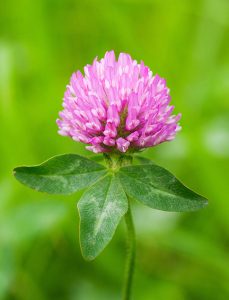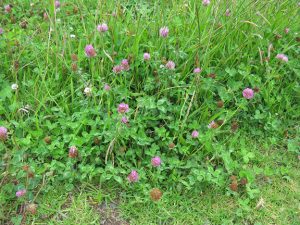Bulletin #2259, Maine Forage Facts: Red Clover
Bulletin #2259, Maine Forage Facts: Red Clover (PDF)
By Jaime Garzon, Assistant Extension Professor and Forage Educator, University of Maine Cooperative Extension
For information about UMaine Extension programs and resources, visit extension.umaine.edu.
Find more of our publications and books at extension.umaine.edu/publications/.
Red Clover
Red clover (Trifolium pratense L.) is a cool-season perennial legume in New England. This perennial shallow-rooted plant acts as a biennial in Maine, that includes a year of establishment and one year of top production. Leaves are trifoliolate, like alfalfa, with three large leaflets per leaf. The leaves commonly have a white or gray mark shaped like the letter “V.” Leaves and stems are lightly pubescent. Flowers are in clusters at the top of the plant, with dark pink to red color. Growth habit varies from erect to prostrate. Numerous stems with large trifoliate leaves arise from the crown region each year. Red clover has a thick tap root that grows 24–36 inches. Lateral roots arising from the tap root are concentrated mainly in the upper five inches of the soil.
Site Selection
Red clover will grow moderately well in slightly acid soils (5.5 to 6.0 pH). However, maximum yields are obtained when soil pH is 6.0 or higher. Red clover has deeper roots than white clover and strives in lands where drainage is unsuitable for alfalfa. It will grow on a wide variety of soil types, from sandy loams to silty clay loams of moderate to high fertility levels.
Soil preparation and establishment
Red clover can be seeded in several ways, depending on how the forage will be used. Red clover is commonly frost-seeded into existing grass pastures, by broadcasting the seeds on the frozen ground. The soil freezing and thawing will work for the seed to germinate, but this must be done under very specific weather conditions at the end of the winter season. For more information, watch the UMaine Extension instructional video to learn more about frosting seed.
Red clover can be planted in a conventionally prepared seedbed in spring (April to early May) or using a no-till drill in established pastures.
Red clover should be seeded at 8 to 12 pounds per acre rate in a pure stand and 2 to 4 pounds per acre when seeded together with other forage grass. Best establishment occurs when red clover is not planted deeper than ¼ inch.
To ensure adequate nodulation, red clover seed should be inoculated with Rhizobium trifolii bacteria and a sticking agent before seeding. Pre-inoculated seeds should be kept in a cool, dark place to optimize the survival of nitrogen-fixing bacteria.
Liming and fertilization
Soil tests are required for the proper determination of soil nutrient availability. In soils with a pH below 6.0, adding lime is essential to make the soil less acidic and to improve red clover’s nitrogen-fixing activity.
Nitrogen fertilization should be avoided to not impact the legume’s N fixation. Without a soil test, it is recommended to apply 20–85 pounds of phosphate (P2O5) per acre and 0–45 pounds of potash (K2O) per acre for the establishment. When red clover is seeded with small grains during winter, 60 pounds of P2O5 top-dressed during seeding has proven beneficial, especially if the soil is low in phosphorus. If inoculated, it is not advisable to mix seeds in the same tank with the fertilizer since this could reduce the effectiveness of the inoculant.
Varieties
Common medium: This variety is faster at the establishment than alfalfa and better adapted to wetter and lower pH soils. Common medium red clover can be a good alternative to alfalfa in heavier soils and as a forage that does not lose quality as quickly as it matures. However, it has less tolerance to drought and low winter hardiness.
Freedom MR: Named due to its lower amounts of pubescence (non-glandular hairs), red clover Freedom MR is one of the latest red clovers developed for Barenbrug USA. It is ideal for hay production due to less hairiness. This promotes faster drying in the field and reduces the chance of loss of quality due to untimely rainfall. In addition, less pubescence also reduces the dustiness of hay. Freedom MR is mildew-resistant and can be used for grazing and silage too.
Mammoth: This is a tall (2–3 inches), quick-growing clover. It will grow in more acidic soil (pH 5.0-6.0) than other clovers if lime is applied before seeding. Large plants with big leaves make it an ideal grazing crop. Mammoth red clover can fix 70–110 pounds of nitrogen per acre. This is a late flowering variety, usually with one or two cuts per year.
Productivity

The yield potential of red clover is near that of alfalfa for the first year (3–4 tons dry matter per acre), but winterkill usually thins the stand before the second production year. Red clover is best suited to short crop rotation if it is grown for hay or silage. In this way, some forage is harvested, and the clover provides nitrogen for the following crop (like corn or potatoes). Individual red clover plants in pastures do not survive more than two years, but natural reseeding is possible. Most pastures in Maine have naturally enough occurring clover (either red or white) that adjustments in soil pH, phosphorus, and potassium will increase the proportion of clover in the forage.
The first harvest is suggested at least 60–90 days after establishment (about 10 percent bloom), with subsequent cuttings at 30–35 day intervals. Harvest at pre-bloom or early bloom stage. Red clover needs 45 days after the last fall cutting to recover and store carbohydrates before the first hard frost. Harvesting too late in the fall, not allowing adequate recovery, or harvesting in very hot and dry conditions can reduce stand longevity.
Grazing management
Rotational grazing is recommended when plants reach a height of 6–8 inches. A stocking rate of 2–5 animal units per acre is recommended. Graze the plants to about 3–4 inches and move to the next pasture.
The proportion of red clover should not exceed 30 percent in grazing pastures to avoid bloat. This digestive disorder can occur on any forage low in fiber and high in protein but is most common in immature legume pastures. Frost, dew, or rain on the field often increase the likelihood of bloat. Bloat incidence is likely to increase during rapid plant growth in the spring or following a summer rain.
Diseases and pests
Anthracnose stem disease, mildew, and root borers (clover root borer and clover root curculio) are threats that can affect red clover. These insects can kill most clover plants in the second hay year.
- Clover root curculio. A short-snouted, dark gray to brown weevil or a grayish white, legless brown-headed grub about 1/6-inch long. Plants wilt and die during dry weather from feeding along the roots and girdling near the crown. Injury is most severe in late spring and early fall.
- Clover root borer. A very small black or dark brown, cylindrical beetle or very small, legless, curved brown-headed grub about 1/10-inch long. They feed on the root surface and tunnel through the roots, causing clover to turn brown, wilt, and die. Injury is most common in old stands of clover.
The best methods against diseases and pests are to use resistant varieties, proper cutting or grazing management, and crop rotation.
References
Griffin TS. (2004). Forage facts: growing forage legumes in Maine (Report 2261). University of Maine Cooperative Extension. Orono (ME), United States.
Hall. M. (1993) Red clover. Pennsylvania State University Extension. University Park (PA), United States.
Herbert S, Hashemi M, Chickering-Sears C, Weis S. (2020). Red clover (Report 319). University of Massachusetts Extension. Amherst (MA), United States.
Johnny’s Selected Seeds. Seed catalog.
King’s Agriseeds Inc. Seed catalog.
Thomas-Murphy J, Amsili J, Bergstrom G, Cherney J, Hansen J, Helms M, Hunter M, Kettering Q, Lawrence J, van Es H, Smith E, Smith M, Stanyard M, Workman K. (2023). Cornell Guide for Integrated Field Crop Management. University of Cornell Cooperative Extension. Ithaca (NY), United States. pp 90-91.
Undersander D, Combs D. (2020). Bloat. University of Wisconsin-Extension. Madison (WI), United States.
Wheaton HN. (1993). Red clover. University of Missouri Extension. Columbia (MO), United States.
Information in this publication is provided purely for educational purposes. No responsibility is assumed for any problems associated with the use of products or services mentioned. No endorsement of products or companies is intended, nor is criticism of unnamed products or companies implied.
© 2024
Call 800.287.0274 (in Maine), or 207.581.3188, for information on publications and program offerings from University of Maine Cooperative Extension, or visit extension.umaine.edu.
In complying with the letter and spirit of applicable laws and pursuing its own goals of diversity, the University of Maine System does not discriminate on the grounds of race, color, religion, sex, sexual orientation, transgender status, gender, gender identity or expression, ethnicity, national origin, citizenship status, familial status, ancestry, age, disability physical or mental, genetic information, or veterans or military status in employment, education, and all other programs and activities. The University provides reasonable accommodations to qualified individuals with disabilities upon request. The following person has been designated to handle inquiries regarding non-discrimination policies: Director of Equal Opportunity, 5713 Chadbourne Hall, Room 412, University of Maine, Orono, ME 04469-5713, 207.581.1226, TTY 711 (Maine Relay System).


